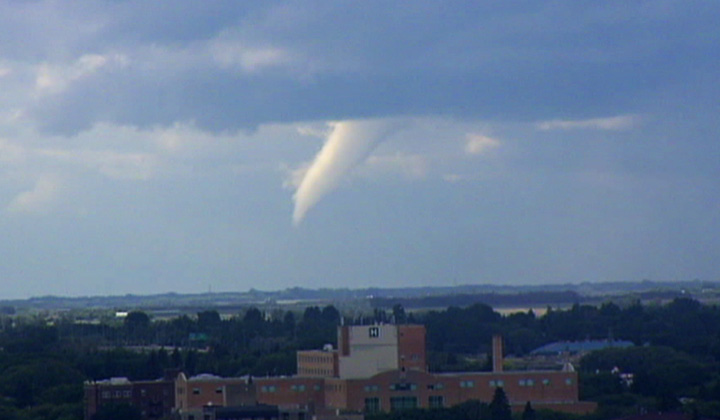SASKATOON – Although Saskatoon is not located in ‘tornado alley,’ residents should still be fully prepared for tornado season in the province.

Saskatchewan’s tornado season typically runs from May to August. However, in 2012, 33 tornadoes were reported with the vast majority touching down between mid-June to the end of July, according to the city.
Environment Canada says on average, about 43 tornadoes occur annually across the Prairies.
Every tornado has the potential to be lethal, even in Saskatchewan where one of the most deadly Canadian tornadoes, the Regina Cyclone, took place in 1912 when 30 people died.
Tornadoes are violently rotating columns of air which exhibit a high degree of variability in appearance, direction, speed, strength and danger.
According to Environment Canada, tornadoes can produce some of the highest wind speeds on the planet. The majority of Canadian tornadoes have a maximum wind speed under 180 km/h, but a small percentage can be considerably stronger.
The federal department also says tornadoes usually move from the southwest, west or northwest direction but that can suddenly change. Groundspeed can vary from nearly stationery to 90 km/h.
“If you see a tornado, and it does not appear to be moving, it is likely either moving straight away from you or straight towards you,” says the Environment Canada website.
Because tornadoes can develop so quickly, the city of Saskatoon believes it is important that residents know what to do in an emergency to reduce the risk of personal harm.
- Roll Up To Win? Tim Hortons says $55K boat win email was ‘human error’
- Ontario premier calls cost of gas ‘absolutely disgusting,’ raises price-gouging concerns
- Bird flu risk to humans an ‘enormous concern,’ WHO says. Here’s what to know
- Election interference worse than government admits, rights coalition says
Businesses and families should decide on a meeting place to gather after a severe storm to ensure that everyone is safe and accounted for in case of separation. Another way, is having an out-of-area contact memorized beforehand.
When residents are caught outdoors during a tornado and no shelter is available, they should lie flat in a ditch, ravine or other low-lying area and shield the head. Keep away from telephone/power lines, fences, trees and hilltops.
If driving, get out and away from the vehicle, as it could be blown away. Open the windows slightly, set the brakes and park off the road away from tall objects and power lines. Run at a right angle away from to the storm’s path.
Avoid large halls, arenas and shopping malls as their roofs could collapse during a tornado.
Take shelter immediately during tornadoes, preferably in the basement or lower level of a sturdy building at the centre of the structure. If there is no basement, crouch or lie flat in an inner hallway, small inner room or stairwell, away from outer walls and windows.
Flying glass and debris is one of the largest dangers during these storms. Therefore it is important to protect one’s self by placing mattresses and/or heavy furniture over themselves.
Once inside, close all doors and windows securely. Don’t use electrical appliances, landlines and limit use on cellphones. Not using the telephone allows the lines to be open for officials who are busy managing the emergency.
Saskatoon’s Emergency Measures Organization says it is critical to have an emergency kit in the home.
A basic emergency survival kit includes: flashlight, batteries, radio, first-aid kit, candles, matches, food, bottled water, clothing, blankets, toilet paper, medications and a whistle.
Have on hand at least a three day supply of food and water. An adult should be provided with two litres of drinking water per day. In an emergency, water can be retrieved from toilet tanks (not bowls) and water heaters.
Residents may be asked to evacuate their homes by emergency officials before or during a disaster. Follow all instructions from officials, take only essential items and make sure to lock up before leaving.
Lastly, it is important for residents to be weather alert. Understanding weather signs, keeping an eye on the sky and listening for severe weather warnings could make the difference.
Saskatoon media outlets have access to up-to-date weather information and meteorologists. If inclement weather or other impending danger is suspected visit Global News weather.
There is also 91.7FM available on the radio during emergencies. It will be broadcasting emergency information, details, safety tips and evacuation routes.
Want your weather on the go? Download Global News’ Skytracker weather apps for iPhone, iPad and Android.




Comments